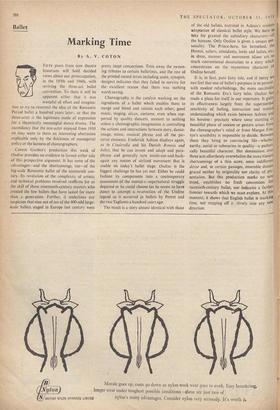Ballet
Marking Time
By A. V. COTON Fit,ry years from now theatre historians will hold decided views about our preoccupation, in the 1950s and 1960s, with reviving the three-act ballet convention. To them it will be apparent either that it was wasteful of effort and imagina- tion to try to resurrect the idea of the Romantic Period ballet a hundred years later : or that the three-acter is the legitimate mode of expression for a theatrically meaningful dance drama. The ascendancy that the one-acter enjoyed from 1910 on may seem to them an interesting aberration explicable only by the fickleness of managerial policy or the laziness of choreographers.
Covent Garden's production this week of Ondine provides no evidence to favour either side of this prospective argument. It has some of the advantages—and• the shortcomings, too—of the big-scale Romantic ballet of the nineteenth cen- tury. Its revelation of the complexity of artistic and technical problems involved reaffirms for us the skill of those nineteenth-century masters who created the few ballets that have lasted for more than a generation. Further, it underlines our suspicion that nine out of ten of the 400-odd large- scale ballets staged in Europe last century were pretty inept concoctions. Trim away the swoon- ing tributes to certain ballerinas, and the rest of the printed record (even including score, synopsis, designs) indicates that they failed to survive for the excellent reason that there was nothing worth saving.
Choreography is the catalyst working on the ingredients of a ballet which enables them to merge and blend and sustain each other; good music, staging, decor, costume, even when sup- ported by quality dancers, amount to nothing unless a choreographic imagination is controlling the actions and interactions between story, dance- image, mime, musical phrase and all the pic- torial elements. Frederick Ashton displays again, as in Cinderella, and his Danish Romeo and Juliet, that he can invent and adapt and para- phrase and generally turn inside-out-and-back- again any notion of stylised movement that is usable on today's ballet stage. Ondine is the biggest challenge he has yet met. Either he could fashion its components into a contemporary assessment of the mortal-v.-supernatural struggle depicted or he could choose (as he seems to have done) to attempt a re-creation of the Undine legend as it occurred in ballets by Perrot and the two Taglionis a hundred years ago.
The result is a story almost identical with those of the old ballets, narrated in Ashton's modern adaptation of classical ballet style. We have to take for granted the subsidiary characters—all the humans. Only Ondine is given a unique per- sonality. The Prince-hero, his betrothed, the Hermit, sailors, attendants, lords and ladies, etc.. in dress, manner and movement idiom are so much conventional decoration to a story which concentrates on the mysterious character of Ondine herself.
It is, in fact, pure fairy tale, and if today WC can feel that one of ballet's purposes is to present, with modest refurbishings, the more successful of the Romantic Era's fairy tales, Ondine has made a place for itself in our repertoire. It gains its effectiveness largely from the supernormal sensitivity of feeling, interaction and mutual understanding which exists between Ashton and his heroine: precisely where some startling or beautiful phase of motion' or gesture arises from the choreographer's mind or from Margot Fon. tyn's sensibility is impossible to decide. Between them they bring to convincing life—whether earthy, aerial 'or submarine in quality—a patheti- cally beautiful character. Her domination over three acts effortlessly overwhelms the more blatant shortcomings of a thin score, some indifferen1 decor and, in certain passages, ensemble dances graced neither by originality nor clarity of pre' sentation. But this production marks no new trend, establishes no fresh convention for twentieth-century ballet, nor indicates a farther frontier towards which we must explore. At this moment, it shows that English ballet is marking time, not stepping off p itively into any new direction.


































 Previous page
Previous page